Culture
Theyyam: Subliming The Material With The Eternal
Venu Gopal Narayanan
Dec 31, 2024, 11:25 PM | Updated Feb 01, 2025, 02:37 PM IST
Save & read from anywhere!
Bookmark stories for easy access on any device or the Swarajya app.
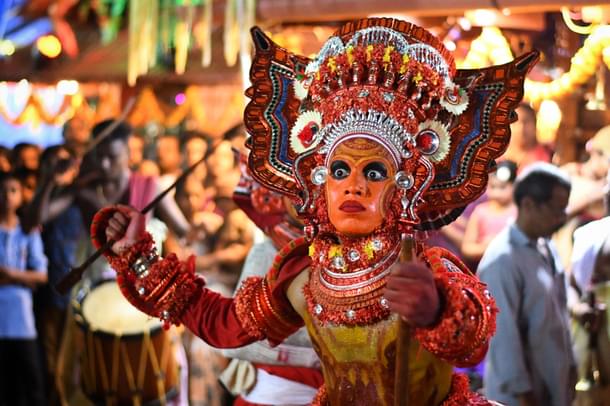
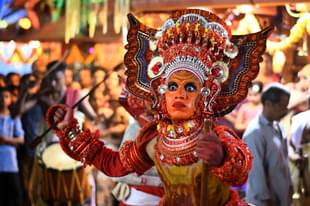
A spectacular Theyyam rite was conducted at Aivarmadhom, on the south bank of the Nila River in central Kerala, on 25 December. By its coverage of the rite, Swarajya aims to capture the atmosphere of the event, its true spiritual meaning, and debunk certain hoary, incorrect narratives about Theyyam which have persisted for simply far too long in the public mind.
At the visual level, Theyyam is a prayer to the gods, through a dance in trance with fearsome, even gruesome, imagery.
It is most commonly conducted in North Malabar, at ancestral homes and temples, by men who have to undergo stringent ritual purifications and severe abstinences in the week prior to the rite. It is not a type of performing art, or even an established secular dance form like what Mohiniattam or Kuchipudi have been reduced to today, but a sacred act of deep piety.
Aivarmadhom is a cremation ground and a popular spot for families to perform their annual death rites for ancestors who have passed on. The presiding deity is Krishna in the form of Parthsarathy – Arjuna’s charioteer.
The atmosphere
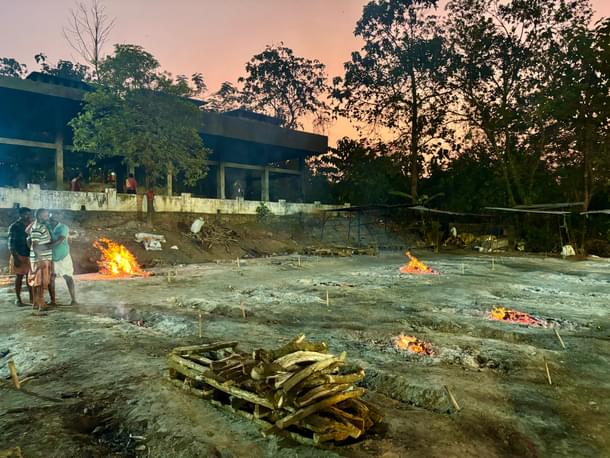
The crowd starts to collect slowly at dusk. The rising darkness mixes with the smoke from burning cremation pyres to create an eerie air. To the left, the pyres burn bright, forcing the souls out of bodies, either as a precursor to rebirth, or for salvation through a final fusing into Brahman. To the right, the sand slopes gently down to the Nila River.
The patron’s family, adorned in fine silks and expensive jewellery, stand on a raised platform in affected humility. But their thunder is stolen by a saree-clad lady sporting a daringly-décolleté blouse. The milling crowd takes in these sights without reaction. They are used to this since it is the essence of human nature that, some come for faith, some to see, and some to be seen. And all the while, life goes on, side by side with death.
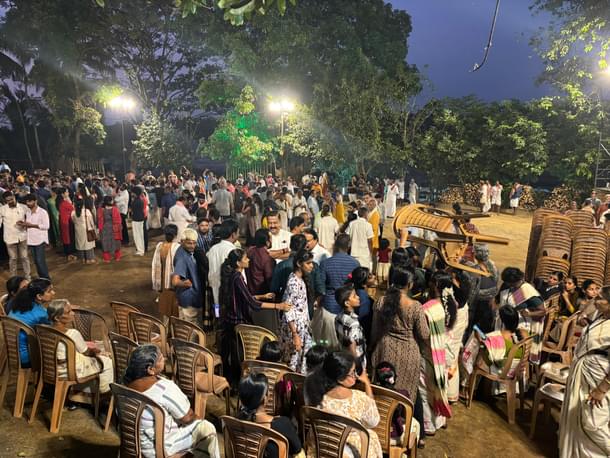
Monks and gurus of various orders are present – some famous, some popular, some neither. One, a giant and a lapsed Marxist with a meagre following who found God with a vengeance, and has remained the bane of communists in a tiny corner of the Vypeen coast, stands tall in faded ochre, crowned by long flowing dreadlocks. Another, slightly more successful, smiles beatifically at anyone who will catch his eye, while tapping his fingertips to the slow beat of drums.
Politicians representing the area at multiple levels, from the village body to the Indian parliament, are mandatorily present. They roost in noisy communion to one side until called upon to speak. All do so with merciful brevity. K Radhakrishnan of the Left, representing Chittur Lok Sabha seat, reminisces proudly of his time as a state minister; apparently, he actively promoted performing arts like Theyyam across Kerala.
The cognoscenti at the back snigger softly at the yawning ignorance behind this gaffe, for, only a deracinated Marxist would not know Theyyam is devotion, not art; that its aesthetic is spiritual, not cultural. But who is going to tell the MP that? No one, since he concludes by wishing everyone a merry Christmas; and just in case anyone isn’t listening, he repeats with a toothy grin: “Today is Christmas”. Facepalm.
Then, the volunteers start stacking logs of wood amidst the crowd, but vertically in a conical fashion, not horizontally like the cremation pyres still burning to the left. Next, small, stump-like objects of bound palm fronds are placed in special enclosures which are decorated with flowers. Purificatory rituals are conducted. The pyres are lit.
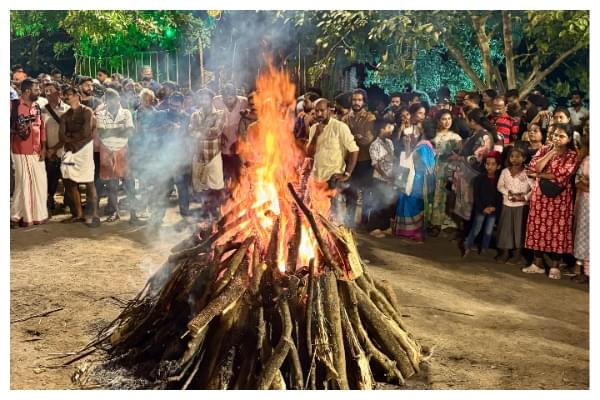
Finally, the Theyyam artistes, already in a state of deep trance, are dragged against their will into the arena. They scream, they roar, they weep; sometimes they break away from the volunteers tasked to retrain them, and rush headlong into the crowd in frenzied bellows. It is a trying task to keep them under control, because spectators can be hurt badly, albeit inadvertently, by such violent pushing and heaving
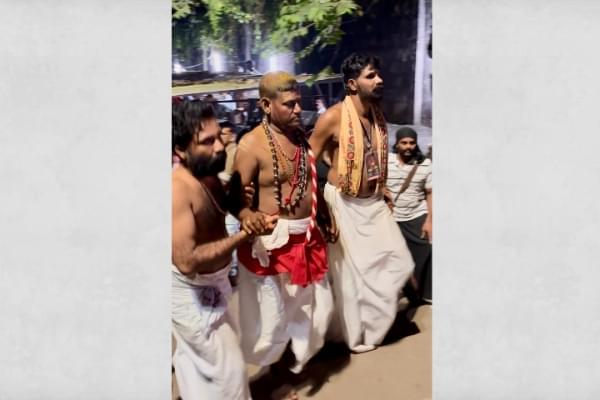
Luckily, the episode ends without incident when, after prayers, the artistes are taken away one at a time, for their ritual bath in the Nila River and a costume change.
The waiting is endless, but worth it. Words do no justice to the drums, the chants, the costumes, the ferociousness of devotion on display, or the blood sacrifice – a rooster. Theyyam has to be experienced in person, if one is to grasp its true meaning. During the grand finale, this writer was lucky to have his section of the crowd charged at by an artiste. Women screamed and fell upon each other to the right. Men gasped and tumbled into a heap to the left.
But this writer stood his ground recording the incident (video here) because, for that one infinitesimal moment when the Theyyam artiste caught his eye with a blackened gaze, instead of rage or fear, all one could sense was the harmless bliss of bhakti.
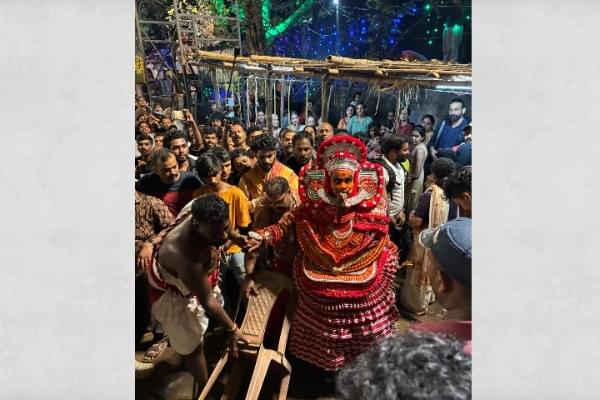
So, what does it all mean? What does this frightening spectacle represent?
The meaning of Theyyam
According to Kaithapram Vasudevan Nambudiri, perhaps the foremost authority on Theyyam today, it is a sacrificial offering to the gods, to propitiate them, to remove or prevent all ills, by invoking divine blessings for the attendees, the patrons, and the land.
“Theyyam is yoga”, he says simply. It is born of dhyanam, or intense contemplation for a sustained period of time. The trance the artistes go into is meditation. It is Puja, invoking the gods into the body of the performers to bless the attendees. The rooster is the naivedyam, the offering to the puja. It is sacrifice.
Nonplussed, this writer asks: “If that is so, then how is Theyyam any different from a Vedic sacrifice? Isn’t this also a form of Homam or Yagna?
“No, it isn’t different”, the Nambudiri chuckles, “At the elemental level, Theyyam is no different from a puja done inside the sanctum sanctorum of a temple”. That is when the penny drops. He is right! The bonfires generate the flames of sacrifice. The artiste is the agent who propitiates Agni, the lord of fire, and hence the awe-inspiring scenes of artistes passing through the flames of the bonfires and the glowing reed torches held by the volunteers on all sides; also, hence, variations on this theme when artistes walk on a bed of scorching, glowing coals.
Without Agni there is nothing, not inside the temple, or at this cremation ground, since it is this sacred flame which acts as a conveyor of prayers and blessings between the devotees and their gods, between the sensory and the eternal realms.
It is cyclical: the patron propitiates the organizers, who in turn propitiate the artistes, who in turn, propitiate Agni, who in turn, conveys these prayers to the gods. In return, Agni brings back divine blessings into the body of the artiste, which are then passed on to the patron, lay devotees present, and the land, with the potency and ferocity they merit.
The assemblage at Aivarmadhom is simultaneously, thus, stage, prop, participant and conduit. And, really, if you think about it, this fire sacrifice is no different from the ones still in progress to the left of the arena, where multiple cremation pyres continue to burn. Ergo, there is no difference between the living and the dead, since the soul is eternal, and the intricate symbolism of the Theyyam at Aivarmadhom, of a sacrificial rite at a cremation ground, is the ineluctable proof.
If this be the case, then why does the mainstream narrative frame Theyyam in casteist-subaltern terms?
Debunking misleading narratives
The stock narrative bandied about in mainstream media and popular culture is that Theyyam is a ‘subaltern’ tradition, the preserve of ‘lower castes’, and/or a rustic rural art form.
It is subtly projected as a strand of worship which developed independently and separately from Vedic or Mimamsic protocols, by which, it is then neatly positioned as an ‘indigenous’, incipient alternative to traditional, patriarchal Brahminical modes of worship (whatever those words mean).
But the truth is that such narratives are utter bunk, and entirely devoid of factual basis. Kaithapram Vasudevan Nambudiri shakes his head sadly: there is no caste angle to Theyyam, nor is there anything subaltern about it, since the rite is both conducted and performed by all castes, in the homes of all castes (and their temples too). Go to North Malabar and see for yourself, he advises.
The point merits reiteration because of the strength of prevailing narratives: not only is there no caste hegemony for these rituals, but they are also indistinguishable from the oblations conducted within the garbha griha or sanctum sanctorum of a temple, because the agent which transports propitiations and blessings is the same – Agni, the sacred fire.
In which case, it is important to understand the extent to which ignorance has been so completely institutionalised by these narratives, most probably wilfully, because it ties in elegantly with Marxian constructs seeking to give ‘lower castes’ a separate identity with which to ‘smash Brahminical patriarchy’. In order to eradicate religion, the opium of the masses, the starting point is always the contestation or deconstruction of prevailing traditions and customs.
This is how deracination, or the creation of rootlessness, works in practice. No wonder the local parliamentarian was incapable of perceiving Theyyam as anything other than a mere form of folk dance – a congenital inability to recognize that Theyyam is comprehensively and completely grounded in the age-old rules of temple worship.
So, it is also no wonder that the many tourists in attendance at Aivarmadhom missed the essence of the rite. They simply didn’t know that when the drums reach their crescendo, and Bhagavathi’s devotee, the Theyyam artiste, bares his fangs, it is a moment for prayer, and not one to coo in cutesy awe. The spiritual symbolism of a deathly dance at a crematorium was lost on them.
Never mind; this is how a civilisational awakening is wrought: slowly, with truths. For, in the final analysis, Theyyam is the reiteration of ancient Dharmic truths: everyone is interlinked; the way of this world is this way of life; and be it life, death or deed, nothing is permanent because everything is eternal.
Venu Gopal Narayanan is an independent upstream petroleum consultant who focuses on energy, geopolitics, current affairs and electoral arithmetic. He tweets at @ideorogue.





